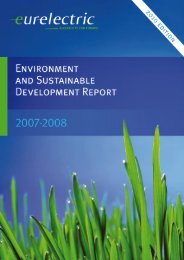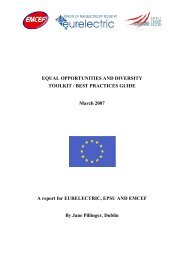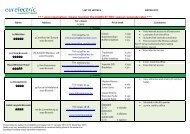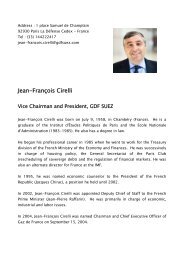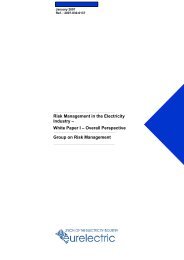European Commission's Consultation on the Europe ... - Eurelectric
European Commission's Consultation on the Europe ... - Eurelectric
European Commission's Consultation on the Europe ... - Eurelectric
Create successful ePaper yourself
Turn your PDF publications into a flip-book with our unique Google optimized e-Paper software.
<str<strong>on</strong>g><strong>Europe</strong>an</str<strong>on</strong>g> <str<strong>on</strong>g>Commissi<strong>on</strong>'s</str<strong>on</strong>g> <str<strong>on</strong>g>C<strong>on</strong>sultati<strong>on</strong></str<strong>on</strong>g> <strong>on</strong><br />
<strong>the</strong> <strong>Europe</strong> 2020 Project B<strong>on</strong>d Initiative<br />
‐‐‐‐‐‐‐‐‐‐‐‐‐‐‐‐‐‐‐‐‐‐‐‐‐‐‐‐‐‐‐‐‐‐‐‐‐‐‐‐‐‐‐‐‐‐‐‐‐‐‐‐‐‐‐‐‐‐‐‐‐‐‐‐‐‐‐‐‐‐‐‐‐‐‐‐‐‐‐‐‐‐‐‐‐‐‐‐‐‐‐‐‐‐‐‐‐‐<br />
A EURELECTRIC Resp<strong>on</strong>se Paper<br />
May 2011
The Uni<strong>on</strong> of <strong>the</strong> Electricity Industry–EURELECTRIC is <strong>the</strong> sector associati<strong>on</strong> representing <strong>the</strong> comm<strong>on</strong> interests of<br />
<strong>the</strong> electricity industry at pan‐<str<strong>on</strong>g><strong>Europe</strong>an</str<strong>on</strong>g> level, plus its affiliates and associates <strong>on</strong> several o<strong>the</strong>r c<strong>on</strong>tinents.<br />
In line with its missi<strong>on</strong>, EURELECTRIC seeks to c<strong>on</strong>tribute to <strong>the</strong> competitiveness of <strong>the</strong> electricity industry, to<br />
provide effective representati<strong>on</strong> for <strong>the</strong> industry in public affairs, and to promote <strong>the</strong> role of electricity both in <strong>the</strong><br />
advancement of society and in helping provide soluti<strong>on</strong>s to <strong>the</strong> challenges of sustainable development.<br />
EURELECTRIC’s formal opini<strong>on</strong>s, policy positi<strong>on</strong>s and reports are formulated in Working Groups, composed of<br />
experts from <strong>the</strong> electricity industry, supervised by five Committees. This “structure of expertise” ensures that<br />
EURELECTRIC’s published documents are based <strong>on</strong> high‐quality input with up‐to‐date informati<strong>on</strong>.<br />
For fur<strong>the</strong>r informati<strong>on</strong> <strong>on</strong> EURELECTRIC activities, visit our website, which provides general informati<strong>on</strong> <strong>on</strong> <strong>the</strong><br />
associati<strong>on</strong> and <strong>on</strong> policy issues relevant to <strong>the</strong> electricity industry; latest news of our activities; EURELECTRIC<br />
positi<strong>on</strong>s and statements; a publicati<strong>on</strong>s catalogue listing EURELECTRIC reports; and informati<strong>on</strong> <strong>on</strong> our events and<br />
c<strong>on</strong>ferences.<br />
EURELECTRIC pursues in all its activities <strong>the</strong> applicati<strong>on</strong> of<br />
<strong>the</strong> following sustainable development values:<br />
Ec<strong>on</strong>omic Development<br />
Growth, added‐value, efficiency<br />
Envir<strong>on</strong>mental Leadership<br />
Commitment, innovati<strong>on</strong>, pro‐activeness<br />
Social Resp<strong>on</strong>sibility<br />
Transparency, ethics, accountability<br />
Dépôt légal: D/2011/12.205/24
<str<strong>on</strong>g><strong>Europe</strong>an</str<strong>on</strong>g> <str<strong>on</strong>g>Commissi<strong>on</strong>'s</str<strong>on</strong>g> <str<strong>on</strong>g>C<strong>on</strong>sultati<strong>on</strong></str<strong>on</strong>g> <strong>on</strong> <strong>the</strong> <strong>Europe</strong><br />
2020 Project B<strong>on</strong>d Initiative<br />
‐‐‐‐‐‐‐‐‐‐‐‐‐‐‐‐‐‐‐‐‐‐‐‐‐‐‐‐‐‐‐‐‐‐‐‐‐‐‐‐‐‐‐‐‐‐‐‐‐‐‐‐‐‐‐‐‐‐‐‐‐‐‐‐‐‐‐‐‐‐‐‐‐‐‐‐‐‐‐‐‐‐‐‐‐‐‐‐‐‐‐‐‐‐‐‐‐‐<br />
Focus Group Finance & Ec<strong>on</strong>omics<br />
Michael Laengle (AT); Chairman; Ignacio Martinez Del Barrio (ES); Vice‐Chairman<br />
J<strong>on</strong>as Akess<strong>on</strong> (SE); Said Salman Al Zaabi (AE); Olga Arutyunova (RU); Moshe Bachman (IL); Uldis Bariss (LV);<br />
Jan Brozik (CZ); C<strong>on</strong>stantin Chivulescu (RO); Abdelkader Choual (DZ); Erzsébet Darida (HU); Vittorio<br />
D'ecclesiis (GB); Miriam Garcia Madruga (ES); Janek Gustavs<strong>on</strong> (EE); Piotr Komosa (PL); Eric Mauer (LU);<br />
Patrick Neuhaus (CH); Valeria Palmisano (IT); Javier Pastor Zuazaga (ES); Pavlos Pattichis (CY); Stefan<br />
Peturss<strong>on</strong> (IS); Miguel Ribeiro Ferreira (PT); Guy Ruelle (BE); Erika Sabova (SK); Anna Siganou‐Kamileri (GR);<br />
Sabri Simsek (TR); Bengt Soderlund (FI); Ingvar Solberg (NO);<br />
Focus Group Enterprise Risk Management<br />
Vittorio D'ecclesiis (IT), Chairman; Michael Herrmann (DE), Vice‐Chairman<br />
Peter Agh (SK); José Allen Lima (PT); Fredrik Arno (SE); Roberto Balzerani (IT); Michael Broustis (GR); Erik<br />
Hagland (SE); Harald Hauer (AT); John Healy (IE); Walter Hollenstein (CH); Filip H<strong>on</strong>s (BE); Paavo Hyv<strong>on</strong>en<br />
(FI); Iñigo Ibarr<strong>on</strong>do (ES); Murathan Kara (TR); Gabor Lavich (HU); Anne Le Lorier (FR); Heikko Mae (EE);<br />
Ignacio Martinez Del Barrio (ES); Shahid Mirza (GB); Francisco Perez Thoden (ES); Thomas Polzer (AT);<br />
Alistair Smith (GB); Marcel Steinbach (DE)<br />
C<strong>on</strong>tact:<br />
Charlotte RENAUD, Policy Officer, Management Unit – crenaud@eurelectric.org
General comments<br />
EURELECTRIC, <strong>the</strong> sector associati<strong>on</strong> representing <strong>the</strong> electricity industry at pan‐<br />
<str<strong>on</strong>g><strong>Europe</strong>an</str<strong>on</strong>g> level, welcomes <strong>the</strong> c<strong>on</strong>sultati<strong>on</strong> launched by <strong>the</strong> <str<strong>on</strong>g><strong>Europe</strong>an</str<strong>on</strong>g> Commissi<strong>on</strong> (EC)<br />
and <strong>the</strong> <str<strong>on</strong>g><strong>Europe</strong>an</str<strong>on</strong>g> Investment Bank (EIB) <strong>on</strong> <strong>the</strong> “<strong>Europe</strong> 2020 Project B<strong>on</strong>d Initiative”<br />
and welcomes <strong>the</strong>ir initiative to engage with stakeholders <strong>on</strong> this key issue.<br />
Electricity is key to a secure, sustainable and competitive future energy supply. Indeed,<br />
our sector is facing a huge challenge up to 2020 and bey<strong>on</strong>d. The priorities set in <strong>the</strong><br />
<strong>Europe</strong> 2020 Strategy clearly pinpoint <strong>the</strong> electricity sector as a key vehicle for <strong>the</strong><br />
transiti<strong>on</strong> towards a low‐carb<strong>on</strong> ec<strong>on</strong>omy and a motor for sustainable growth.<br />
The <str<strong>on</strong>g><strong>Europe</strong>an</str<strong>on</strong>g> electricity sector is determined to play this role but insists that <strong>the</strong> right<br />
policy framework should be provided. <strong>Europe</strong> is at an unprecedented energy crossroads,<br />
facing an urgent need for sizeable power generati<strong>on</strong> and grid infrastructure investments<br />
in <strong>the</strong> near future – an estimated <strong>on</strong>e trilli<strong>on</strong> euro by 2020 as indicated in <strong>the</strong> <str<strong>on</strong>g><strong>Europe</strong>an</str<strong>on</strong>g><br />
Commissi<strong>on</strong> Infrastructure Package 1 published in November 2010.<br />
Carrying out <strong>the</strong>se investments in a timely manner is essential if <strong>Europe</strong> is to meet its<br />
energy and climate targets.<br />
In this perspective, EURELECTRIC welcomes <strong>the</strong> “<strong>Europe</strong> 2020 Project B<strong>on</strong>d Initiative” in<br />
<strong>the</strong> belief that it could help attract private sector investors and mobilise private savings<br />
to support <strong>the</strong> EU’s strategic infrastructure needs and large projects of <str<strong>on</strong>g><strong>Europe</strong>an</str<strong>on</strong>g> interest.<br />
Using funding from <strong>the</strong> EU budget as well as EIB guarantees and expertise could provide<br />
powerful leverage to enhance <strong>the</strong> credit ratings of b<strong>on</strong>ds issued by project companies<br />
and to increase <strong>the</strong> attractiveness of l<strong>on</strong>g‐term investment for private sector participants.<br />
1 Communicati<strong>on</strong> “Energy infrastructure priorities for 2020 and bey<strong>on</strong>d – A Blueprint for an integrated <str<strong>on</strong>g><strong>Europe</strong>an</str<strong>on</strong>g> energy network”<br />
(COM/2010/677).<br />
1
General questi<strong>on</strong>s<br />
1) Is <strong>the</strong> chosen mechanism likely to attract private sector instituti<strong>on</strong>al investors to<br />
<strong>the</strong> sectors of transport, energy and ICT in particular? If you are an investor,<br />
would you be prepared to buy such project b<strong>on</strong>ds?<br />
EURELECTRIC believes that in <strong>the</strong> coming years capital markets will probably become<br />
tighter and fierce competiti<strong>on</strong> for access to financing facilities is likely to grow.<br />
EURELECTRIC believes that <strong>the</strong>re will be a growing tensi<strong>on</strong> within capital markets due to,<br />
<strong>on</strong> <strong>the</strong> <strong>on</strong>e hand, increasing financing needs, and <strong>on</strong> <strong>the</strong> o<strong>the</strong>r hand, <strong>the</strong> probable<br />
progressively restrictive m<strong>on</strong>etary policy following governments’ excepti<strong>on</strong>al measures to<br />
stimulate <strong>the</strong> ec<strong>on</strong>omy after <strong>the</strong> recent financial crisis.<br />
EURELECTRIC believes that <strong>the</strong> increasing financing needs are related to a c<strong>on</strong>current<br />
demand for funding coming from both <strong>the</strong> private and public sectors. As far as <strong>the</strong> private<br />
sector is c<strong>on</strong>cerned, <strong>the</strong> industrial sector, and in particular <strong>the</strong> energy sector, is<br />
developing <strong>on</strong>e of <strong>the</strong> most ambitious infrastructure plans, both in producti<strong>on</strong> and in<br />
transmissi<strong>on</strong>/distributi<strong>on</strong>, that will require an unprecedented financial effort to deliver a<br />
low‐carb<strong>on</strong> and secure energy supply. Meanwhile, <strong>the</strong> financial sector will be heavily<br />
impacted by more stringent capital requirements that will ultimately force financial<br />
instituti<strong>on</strong>s to use a substantial part of <strong>the</strong>ir cash facilities to reinforce <strong>the</strong>ir own balance<br />
sheets. At <strong>the</strong> same time, <strong>the</strong> public sector will also seek additi<strong>on</strong>al credit, with most<br />
governments struggling to comply with <strong>the</strong>ir debt ratios. All <strong>the</strong>se growing financial<br />
needs will most likely occur in a phase of restrictive m<strong>on</strong>etary policy when internati<strong>on</strong>al<br />
risk‐free base rates are expected to increase.<br />
In this c<strong>on</strong>text, <strong>the</strong> launch of a <str<strong>on</strong>g><strong>Europe</strong>an</str<strong>on</strong>g> Project B<strong>on</strong>ds scheme appears to be an effective<br />
instrument for attracting private capital for two main reas<strong>on</strong>s:<br />
• Such a mechanism will incentivise <strong>the</strong> participati<strong>on</strong> of new private<br />
instituti<strong>on</strong>al investors in <strong>the</strong> above‐menti<strong>on</strong>ed sectors by improving <strong>the</strong><br />
projects’ credit profile in a c<strong>on</strong>text where huge amounts of capital will be<br />
needed to develop <strong>the</strong> <str<strong>on</strong>g><strong>Europe</strong>an</str<strong>on</strong>g> energy, transport and ICT infrastructures.<br />
Given <strong>the</strong> c<strong>on</strong>strained situati<strong>on</strong> in <strong>the</strong> capital markets, some type of public<br />
guarantee will be helpful to attract private investment. The public<br />
guarantee will c<strong>on</strong>tribute to <strong>the</strong> ec<strong>on</strong>omic feasibility of projects and may<br />
be justified <strong>on</strong> <strong>the</strong> grounds of <strong>the</strong> positive external effects that <strong>the</strong>se<br />
infrastructure projects will involve.<br />
• Such project b<strong>on</strong>ds, which represent a new asset class per se, will offer a<br />
large range of investors, such as sectoral funds, hedge funds, private<br />
equity, pensi<strong>on</strong> funds, etc., <strong>the</strong> opportunity to diversify <strong>the</strong>ir portfolio and<br />
to better shape <strong>the</strong> reward/risk profile of <strong>the</strong>ir assets.<br />
EURELECTRIC believes that rating agencies will play an important role within such an<br />
initiative. Clearly, EU‐supported credit enhancement, which would guarantee <strong>the</strong> debt<br />
service obligati<strong>on</strong>s of special purpose companies/project companies to investors in<br />
2
project b<strong>on</strong>ds, will be a prerequisite for issuing such project b<strong>on</strong>ds (being o<strong>the</strong>rwise n<strong>on</strong>‐<br />
resourced) at all; in unregulated businesses investors will require more guarantees than<br />
in regulated businesses with stable cash flows. However, <strong>the</strong> attractiveness of such b<strong>on</strong>ds<br />
will largely depend <strong>on</strong> how rating agencies will factor any EU‐supported credit<br />
enhancement into <strong>the</strong> rating of project b<strong>on</strong>ds. Generally speaking <strong>the</strong> higher <strong>the</strong><br />
guarantee from <strong>the</strong> EIB or o<strong>the</strong>r EU‐backed partners <strong>the</strong> more attractive <strong>the</strong> project b<strong>on</strong>d<br />
will be for investors.<br />
Fur<strong>the</strong>rmore, EURELECTRIC would like to stress that <strong>the</strong> main problem with regard to<br />
<strong>the</strong>se projects is <strong>the</strong>ir l<strong>on</strong>g c<strong>on</strong>structi<strong>on</strong> period and <strong>the</strong> related pre‐financing needs,<br />
which b<strong>on</strong>dholders are not usually pr<strong>on</strong>e to fund.<br />
EURELECTRIC would also like to stress that <strong>the</strong> “<strong>Europe</strong> 2020 Project B<strong>on</strong>d Initiative” will<br />
not succeed in achieving its goal of attracting additi<strong>on</strong>al private sector financing if it is not<br />
accompanied by <strong>the</strong> implementati<strong>on</strong> of EU regulati<strong>on</strong> focused <strong>on</strong> providing a higher<br />
degree of standardisati<strong>on</strong> am<strong>on</strong>g Member States, in order to avoid fur<strong>the</strong>r efforts to be<br />
carried out by potential investors based <strong>on</strong> <strong>the</strong> local specificities of each country.<br />
2) Are <strong>the</strong>re o<strong>the</strong>r sectors with large‐scale infrastructure financing needs that<br />
should be included?<br />
Although <strong>the</strong> same logic could be applied to o<strong>the</strong>r sectors with large‐scale infrastructure<br />
financing needs, i.e. agriculture, automotive, water, waste water, and waste incinerati<strong>on</strong><br />
etc., EURELECTRIC is of <strong>the</strong> view that <strong>the</strong> sectors menti<strong>on</strong>ed in <strong>the</strong> Stakeholder<br />
<str<strong>on</strong>g>C<strong>on</strong>sultati<strong>on</strong></str<strong>on</strong>g> Paper appear to be <strong>the</strong> most appropriate given <strong>the</strong> priority of <strong>the</strong>ir<br />
infrastructural investments and <strong>the</strong> likely c<strong>on</strong>straints of EU available credit lines, at least<br />
at a first stage. An extensi<strong>on</strong> to o<strong>the</strong>r sectors could be developed <strong>on</strong>ce <strong>the</strong> scheme has<br />
been successfully put in place for energy, transport and ICT in order to diversify any<br />
potential impact <strong>on</strong> <strong>the</strong> EU budget by reducing risk through a cross‐sectoral “portfolio<br />
effect”.<br />
It would be worth stressing <strong>the</strong> eligibility of energy projects related to generati<strong>on</strong>,<br />
transmissi<strong>on</strong>, and distributi<strong>on</strong> system infrastructure and energy efficiency (smart grids).<br />
3
Specific questi<strong>on</strong>s<br />
3) Would <strong>the</strong> credit enhancement facilitate/accelerate <strong>the</strong> c<strong>on</strong>clusi<strong>on</strong> of financing<br />
packages?<br />
EURELECTRIC believes that <strong>the</strong> credit enhancement mechanism could be useful in<br />
attracting private investment for infrastructure projects. Given <strong>the</strong> c<strong>on</strong>straint that direct<br />
public funding should not be increased, this credit enhancement becomes increasingly<br />
important. As menti<strong>on</strong>ed above, without this type of public support, some projects with a<br />
high added‐value in terms of security of supply might not be commercially viable.<br />
However, <strong>the</strong> benefits of <strong>the</strong> credit enhancement measures could in some cases be partly<br />
offset by stringent EIB/EU procedures and will depend <strong>on</strong> two crucial drivers:<br />
• firstly, <strong>the</strong> cost of <strong>the</strong> credit enhancement mechanism;<br />
• sec<strong>on</strong>dly, <strong>the</strong> remunerati<strong>on</strong> framework envisaged for <strong>the</strong> project.<br />
Therefore, in order to enhance <strong>the</strong> efficiency of this instrument, EURELECTRIC believes<br />
that it is crucial that a transparent and efficient eligibility framework is put in place for<br />
<strong>the</strong> applicati<strong>on</strong>s and that <strong>the</strong> due diligence, financial appraisal and pricing phases carried<br />
out by <strong>the</strong> EIB during <strong>the</strong> selecti<strong>on</strong> process are clearly structured with a predefined<br />
schedule and timely deadlines. In this respect, close cooperati<strong>on</strong> between <strong>the</strong> EU/EIB (in<br />
c<strong>on</strong>necti<strong>on</strong> with <strong>the</strong> EU‐supported credit enhancement), <strong>the</strong> arrangers of <strong>the</strong> project<br />
b<strong>on</strong>d and <strong>the</strong> rating agencies will be required. Moreover, we refer to our comments<br />
related to <strong>the</strong> funding during <strong>the</strong> c<strong>on</strong>structi<strong>on</strong> period under questi<strong>on</strong> 1 above.<br />
4) What minimum rating of <strong>the</strong> b<strong>on</strong>ds would be sufficient to attract investors?<br />
B<strong>on</strong>d investors are always in search of a correct risk/reward balance and <strong>the</strong>re is always a<br />
relati<strong>on</strong>ship between <strong>the</strong> b<strong>on</strong>d return and its risk of default. Hence, as l<strong>on</strong>g as a correct<br />
risk/reward balance is respected, <strong>the</strong>re is a possibility to attract investors under certain<br />
rating c<strong>on</strong>diti<strong>on</strong>s. The problem is that in <strong>the</strong> absence of a certain public guarantee to<br />
improve <strong>the</strong> rating, <strong>the</strong> necessary b<strong>on</strong>d remunerati<strong>on</strong> level may become too high to<br />
make <strong>the</strong> project pay‐off possible.<br />
The present “boom” of corporate b<strong>on</strong>ds successfully issued during <strong>the</strong> last two years is<br />
testament to a good appetite in capital markets for financing at investment grade<br />
corporate (BBB‐,Baa3) or even at speculative grade. Therefore at current levels of risk‐<br />
free base rate (ECB 1‐1,5%) an investment grade rating (BBB‐,Baa3) might be sufficient<br />
for attracting financial instituti<strong>on</strong>s and specialised players such as private equity and<br />
pensi<strong>on</strong> funds. Capital markets are likely to become more stringent in terms of rating<br />
with a higher level of risk‐free base rate, since this would imply for financial instituti<strong>on</strong>s a<br />
higher cost of potential defaults and more selectivity due to lower access to primary cash.<br />
With an ECB rate of > 2%, <strong>the</strong> target rating would probably increase to a “good”<br />
investment grade (A/A2).<br />
4
A “good” investment grade (A/A2) should be <strong>the</strong> minimum target also if access to EU<br />
project b<strong>on</strong>ds is extended to <strong>the</strong> final markets of private investors/tax payers through <strong>the</strong><br />
intermediati<strong>on</strong> of banks. The final market of private investors has historically proven to<br />
be less interested in buying b<strong>on</strong>ds from corporates falling within <strong>the</strong> lower range of<br />
investment grade ratings and, <strong>on</strong> <strong>the</strong> o<strong>the</strong>r hand, governments are generally reluctant to<br />
expose tax payers’ savings to default risk.<br />
5) What degree of credit enhancement would be necessary to achieve this rating?<br />
Creditworthiness of project finance is normally dependent <strong>on</strong> 4 main factors:<br />
• Credit standing of sp<strong>on</strong>sors/equity c<strong>on</strong>tributors;<br />
• Predictability, quality and stability of cash flows;<br />
• Level of technology/c<strong>on</strong>structi<strong>on</strong> risk;<br />
• Level of regulatory risk (related to permissi<strong>on</strong>s, c<strong>on</strong>cessi<strong>on</strong>s, licences, compliance<br />
and stability of legal regulatory framework).<br />
The credit enhancement required for achieving <strong>the</strong> desired rating will be a functi<strong>on</strong> of<br />
each project’s specific characteristics in term of <strong>the</strong> project finance risks outlined above.<br />
The due diligence phase performed by <strong>the</strong> EIB might include a specific task of running<br />
sensitivities for <strong>the</strong> main risk drivers of <strong>the</strong> project, based <strong>on</strong> historical data of said risk<br />
drivers and/or a M<strong>on</strong>te Carlo approach. These sensitivities should define a statistical<br />
profile of expected cash flows from <strong>the</strong> projects, highlighting <strong>the</strong> probability of a cash<br />
shortfall and, ultimately, <strong>the</strong> probability of default.<br />
Having set <strong>the</strong> target rating, e.g. A/A2, with <strong>the</strong> associated probability of default, <strong>the</strong> EIB<br />
could size <strong>the</strong> necessary credit enhancement accordingly: in fact <strong>the</strong> required credit<br />
enhancement will be <strong>the</strong> amount necessary to reduce expected cash shortfall and<br />
probability of default to <strong>the</strong> level of probability of default associated to <strong>the</strong> target rating.<br />
In general terms, during <strong>the</strong> c<strong>on</strong>structi<strong>on</strong> phase, <strong>the</strong> project company will draw most<br />
financing facilities for capital expenditures (CAPEX) without producing much cash, and<br />
during <strong>the</strong> operati<strong>on</strong> phase most of CAPEX will have been already spent and <strong>the</strong> project<br />
will starts producing cash flows,. One could expect that Project B<strong>on</strong>ds will be issued and<br />
drawn at <strong>the</strong> start of <strong>the</strong> c<strong>on</strong>structi<strong>on</strong> phase, that interests will be paid during <strong>the</strong><br />
c<strong>on</strong>structi<strong>on</strong> phase and operating phase and that <strong>the</strong> b<strong>on</strong>d will be reimbursed 100% of<br />
principal at maturity. The c<strong>on</strong>structi<strong>on</strong> phase, during which <strong>the</strong>re are little cash flows, if<br />
any, from <strong>the</strong> project to cover <strong>the</strong> interests to be paid, makes <strong>the</strong> whole project riskier<br />
for <strong>the</strong> B<strong>on</strong>d holders.<br />
EURELECTRIC <strong>the</strong>refore believes project b<strong>on</strong>d holders might be fairly protected by sizing<br />
<strong>the</strong> credit enhancement in order to cover interest costs for <strong>the</strong> whole durati<strong>on</strong> of <strong>the</strong><br />
c<strong>on</strong>structi<strong>on</strong> phase: this protecti<strong>on</strong> could be put in relati<strong>on</strong> to <strong>the</strong> lower range of target<br />
ratings.<br />
A higher degree of protecti<strong>on</strong> for project b<strong>on</strong>d holders could be achieved by sizing <strong>the</strong><br />
credit enhancement in order to cover interest costs for <strong>the</strong> whole durati<strong>on</strong> of <strong>the</strong><br />
5
project’s payback period: this protecti<strong>on</strong> could be put in relati<strong>on</strong> to <strong>the</strong> higher range of<br />
target ratings.<br />
6) Which impact would <strong>the</strong> Initiative have <strong>on</strong> financing costs and <strong>on</strong> maturities?<br />
The higher <strong>the</strong> guarantee provided by <strong>the</strong> EIB, <strong>the</strong> better for <strong>the</strong> financing cost of <strong>the</strong><br />
project. Providing a 100% guarantee would lead to <strong>the</strong> same rating as <strong>the</strong> EIB (AAA). A<br />
lower guarantee implies lower ratings, while increasing <strong>the</strong> necessary equity of <strong>the</strong><br />
project and diminishing its leverage.<br />
The credit enhancement guaranteed by EU Project B<strong>on</strong>ds would help to extend<br />
maturities of financing facilities, thus reducing liquidity risk of <strong>the</strong> project. Maturity could<br />
be expected to range up to 15‐20 years, especially if such an initiative is coupled with a<br />
good predictability of cash flows and good credit standing of sp<strong>on</strong>sors for a project that<br />
does not present significant technological challenges in a stable legal/regulatory regime.<br />
As far as <strong>the</strong> cost of financing is c<strong>on</strong>cerned <strong>the</strong> credit enhancement guaranteed by EU<br />
Project B<strong>on</strong>ds will reduce <strong>the</strong> risk premium requested by investors, increasing <strong>the</strong><br />
financial viability of <strong>the</strong> project. The reducti<strong>on</strong> of financing cost due to <strong>the</strong> lower risk<br />
premium should be evaluated against <strong>the</strong> additi<strong>on</strong>al risk premium requested by <strong>the</strong><br />
EU/EIB for <strong>the</strong> risk‐taking and any o<strong>the</strong>r additi<strong>on</strong>al cost (e.g. legal, administrative,<br />
c<strong>on</strong>sultancy fee, structuring fee, etc.) deriving from <strong>the</strong> applicati<strong>on</strong>, due diligence,<br />
financial appraisal, etc.<br />
EURELECTRIC finally notes that project finance schemes in general, after an initial boom,<br />
have been questi<strong>on</strong>ed in terms of actual benefits in financing costs due to <strong>the</strong> complex<br />
and expensive structuring phase. Ultimately project finance has been c<strong>on</strong>sidered an<br />
alternative to corporate finance more for <strong>the</strong> benefit of <strong>the</strong> balance sheet than for that of<br />
financing cost.<br />
7) Is it essential that a single entity acts as c<strong>on</strong>trolling creditor?<br />
For <strong>the</strong> sake of simplicity, as well as in order to minimise informati<strong>on</strong> flows and <strong>the</strong><br />
administrative burden, EURELECTRIC would advise that <strong>the</strong> c<strong>on</strong>trolling creditor role be<br />
managed by <strong>on</strong>e single entity.<br />
6
Uni<strong>on</strong> of <strong>the</strong> Electricity Industry ‐ EURELECTRIC aisbl<br />
Boulevard de l’Impératrice, 66 ‐ bte 2<br />
B ‐ 1000 Brussels • Belgium<br />
Tel: + 32 2 515 10 00 • Fax: + 32 2 515 10 10<br />
VAT: BE 0462 679 112 • www.eurelectric.org



